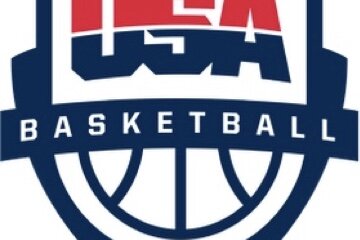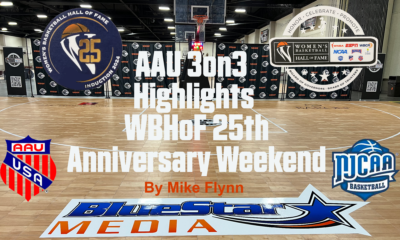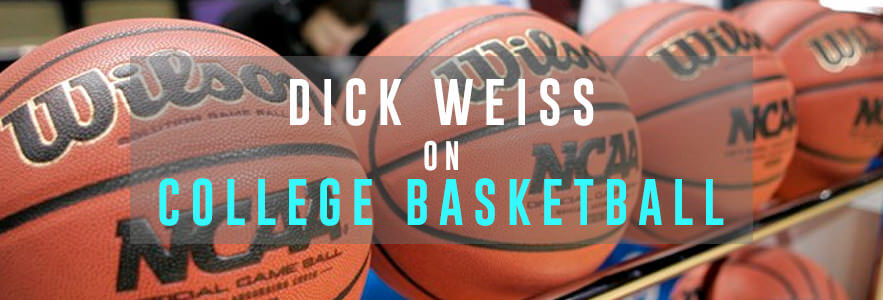Basketball
REVISIONS: National Federation of State High School Associations announce rule changes for upcoming season; flopping will incur a technical foul
 BENSALEM, Pa. – Floppers, beware, you will be warned once before being issued a technical starting with the 2024-25 basketball season.
BENSALEM, Pa. – Floppers, beware, you will be warned once before being issued a technical starting with the 2024-25 basketball season.
The National Federation of State High School Associations announced a series of rules changes have a new definition and subsequent warning for faking being fouled or flopping has been added to the NFHS Basketball Rules Book.
This revision to high school basketball rules was one of 12 changes approved by the NFHS Basketball Rules Committee at its April 9-11 meeting in Indianapolis.
All recommended changes were subsequently approved by the NFHS Board of Directors.
“The committee approved changes addressing a variety of different areas,” NFHS Director of Sports Lindsey Atkinson said in a statement. “Maintaining a focus on player safety, fairness, balance and rules that officials can effectively adjudicate continue to be the focus of the committee.”
Faking being fouled is defined in Rule 4-49-1 as when a player simulates being fouled or makes theatrical or exaggerated movements when there is no illegal contact. Examples include, but are not limited to, embellishing the impact of incidental contact on block/charge plays or field goal attempts, using a “head bob” to simulate illegal contact and using any tactic to create an opinion of being fouled to gain an advantage.
The new language also establishes a procedure for officials to issue a team warning on the first instance of faking being fouled.
The warning is recorded in the scorebook and reported to the head coach. Any additional instances will result in a team technical foul and not a player technical foul, which was previously the case.
A change to Rule 3-4-4a removes the restriction of only lettering being allowed on the front of the jersey. If a logo or mascot is displayed on the front, it must be centered directly above the number in place of identifying names. This change does not require schools to purchase new uniforms and may allow some schools to wear current uniforms that were previously not permitted.
A new note to Rule 9-10-1a and edit to Rule 4-10 allows states that utilize a 35-second shot clock to choose to eliminate the five-second closely guarded provision while a player dribbles the ball. The closely guarded rules remain in effect while a player holds the ball regardless of whether or not a state utilizes a shot clock.
According to the National Federation, other rules changes approved by the committee include the following:
Rule 1-19 clarifies that the use of electronic devices during the game must be limited to recording and tracking stats, reviewing plays or similar contest-related functions. The use of electronic devices for voice or video recording is prohibited.
Rule 2-11-11 notes that if multiple scorers are at the scorer’s bench, the scorer(s) that is not official is responsible for comparing records with the official scorer, who then would notify a referee immediately of a discrepancy. This allows the official scorer to remain focused on game play and places the responsibility of comparing scoring information on auxiliary scorers.
Rule 3-3-6 states that if bench personnel are beckoned to attend to an injured player, whether they enter the court or not, the player is subject to removal from the game unless the coach requests a time-out.
If a player is bleeding or has blood on the uniform, Rule 3-3-7 now allows the player to remain in the game if the issue can be resolved in 20 seconds.
A new exception to Rule 4-6-1 involving basket interference allows for the net to be contacted and play continue if the official determines the contact to not affect the try for a goal.
A collection of changes to rules 4-47-5, 10-2-1g and 10-4-5 allows officials to issue a team warning for delay of game when a ball is not immediately passed to an official when a whistle sounds. Any subsequent violations now result in a team technical instead of a player technical.
Rule 7-1-1 establishes that a player cannot be assisted by team member or bench personnel outside the boundary line to remain inbounds.
Pregame violations were addressed in a series of changes in Rule 10. If both teams violate provisions listed in Rules 10-1-1, 10-1-2 and 10-2-7 in equal numbers, the penalties offset, and no free throws are awarded.
Additionally, the head coach would not lose the privilege of the coaching box. Similarly, the penalty for dunking or attempting to dunk a dead ball in Rule 10-2-7 no longer requires the coach to lose coaching box privileges and no personal foul is assessed as it is now a team technical and not a bench technical.
–From NFHS Office of Communications
Senior Writer and national analyst for Blue Media and compiles the Blue Star Elite 25 national boys and girls high school basketball and football rankings during the season. Lawlor, an award-winning writer, is a voting committee member and advisor for several national high school events, including the McDonald’s All-American Games. He previously wrote for USA TODAY and ESPN.com, where he was the national preps writer, while compiling the national rankings in four sports.

Latest Articles
-


Christopher Lawlor
/ 4 days agoBREAKING: Lisa Bluder steps down as Iowa women’s head coach after leading Hawkeyes to back-to-back Final Fours; Jan Jensen inherits position
IOWA CITY, Iowa – In a shock to some, Iowa women’s head coach Lisa...
-


Christopher Lawlor
/ 1 week agoTwenty-Six Athletes Expected to Participate in USA Basketball Women’s U18 National Team Trials that begin on May 15
COLORADO SPRINGS, Colo. — USA Basketball announced 26 athletes expected to participate in the...
-


Basketball
/ 1 week agoAAU 3on3 Highlights WBHoF 25th Anniversary Weekend
KNOXVILLE – The 25th anniversary weekend celebration of the Women’s Basketball Hall of Fame...
By Mike Flynn -


Christopher Lawlor
/ 2 weeks agoGONE PRO: Blue Star Media Elite 25 football rankings’ regulars Bishop Gorman (NV) and IMG Academy (FL) lead 2024 NFL Draft with three selections apiece
BENSALEM, Pa. – One of the greatest three day stretches annually in professional sports...



